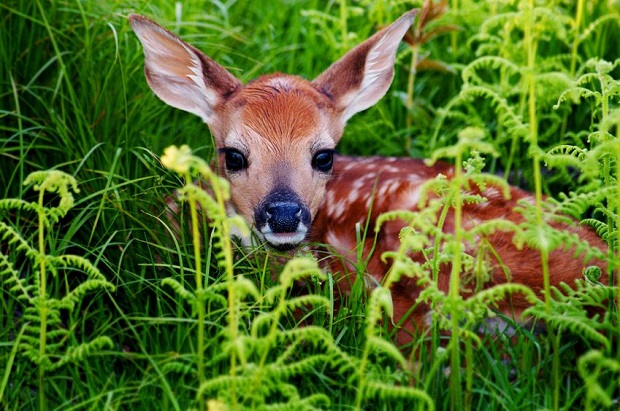Are Deer Colorblind?
Answer at a Glance: Deer are not completely colorblind, but their color vision is limited compared to humans. Deer are more sensitive to movement and low light than to bright colors due to their large eyes and rod-dominated retinas.
Dig Deeper
- Understanding Color: The Visible Light Spectrum
- How the Eye Perceives Color
- What Colors Can Deer See?
- Research Observing How Deer Perceive Color
- References
Understanding Color: The Visible Light Spectrum

Light beams can have a wide variety of wavelengths. Some of these can be seen by our eyes, and some cannot. The eye interprets the differences between visible light wavelengths as colors. As wavelength increases or decreases, the apparent color changes.
The visible light spectrum is arranged in order of wavelength, from longest to shortest, starting with red, followed by orange, yellow, green, blue, indigo, and ending with violet.
How the Eye Perceives Color

The eye perceives color through the interaction of light with special cells in the retina called photoreceptors. Here’s how it works:
1. Light Enters the Eye
- Light reflects off objects and enters the eye through the cornea and lens, which focus it onto the retina at the back of the eye.
2. Photoreceptors Detect Light
In the retina, there are two main types of photoreceptors:
- Rods:
- Sensitive to light intensity (black, white, gray)
- Allow us to see in dim light
- Do not detect color
- Cones:
- Detect color and fine detail
- Work best in bright light
- There are three types in humans:
- S-cones (short wavelengths): sensitive to blue
- M-cones (medium wavelengths): sensitive to green
- L-cones (long wavelengths): sensitive to red
3. Color Processing
- The cones send electrical signals to the brain based on the amount of light they detect.
- The brain (especially the visual cortex) compares the input from the three cone types to interpret colors.
- For example:
- If L-cones and M-cones are highly stimulated but S-cones aren’t, your brain sees yellow.
- If only S-cones are active, you see blue.
Why You See Full-Color Vision
Your brain blends the signals from the three types of cones to produce millions of colors. This system is called trichromatic vision, and it’s how most people with normal vision perceive a full range of colors.
When Things Go Wrong
If one cone type is missing or faulty, a person may experience color vision deficiency (commonly referred to as color blindness).
- Example: Red-green color blindness occurs when L- or M-cones don’t function properly.
What Colors Can Deer See?
Deer have dichromatic vision, which means they see two primary colors instead of the three that humans see. This is due to the absence of the third type of cone photoreceptor in their retinas, which is sensitive to long wavelengths (reds and oranges).
- They can see:
- Blue and short-wavelength colors (like violet).
- Some green shades.
- They cannot see:
- Red, orange, and green the way we do. These colors likely appear as gray or brown to them.
So, while deer aren’t completely colorblind, their world is much more limited in color than ours — mostly shades of blue, gray, and yellowish tones.
Research Observing How Deer Perceive Color
Extensive scientific research supports the idea that deer have a limited color vision. Deer are dichromats, not completely colorblind, but they cannot see long wavelengths (reds and oranges) as we do.
Cone Sensitivity and Retinal Study
In a cone sensitivity and retinal study, researchers employed electroretinogram (ERG) measurements in white-tailed and fallow deer. They found two types of cone photoreceptors: one sensitive to short wavelengths (~450–460 nm, blue) and one to mid-wavelengths (~537–542 nm, green-yellow). They concluded that deer lack the long-wavelength (red) cone found in humans.
Behavioral Discrimination Tests
Researchers conducted behavioral discrimination tests by training sika deer to ascertain if they could discriminate between colors. The researchers found that all the deer could distinguish between blue and white, as well as yellow and green. No deer could differentiate between blue and red-purple or blue-purple, a consistency observed in humans with protanopia (a type of red-green color blindness where the red cones are absent in the eye). The researchers concluded that color vision in sika deer is similar to that in humans with protanopia.
References
- OpenStax. (2023). College Physics 2e, Chapter 26: “Color and Color Vision.”
- Purves, D., Augustine, G. J., & Fitzpatrick, D. (2001). Neuroscience (2nd ed.). Sunderland, MA: Sinauer Associates.
- Kandel, E. R., Schwartz, J. H., Jessell, T. M., Siegelbaum, S. A., & Hudspeth, A. J. (2013). Principles of Neural Science (5th ed.). New York, NY: McGraw‑Hill.
- Jacobs, G. H. (1981). Comparative Color Vision. Academic Press, New York
- Jacobs, G. H., et al. “Electrophysiological Measurements of Spectral Mechanisms in the Retinas of Two Cervids: White-tailed Deer (Odocoileus Virginianus) and Fallow Deer (Dama Dama).” Journal of Comparative Physiology A, vol. 174, no. 5, May 1994, pp. 551–57. https://doi.org/10.1007/bf00217375.
- Okubo, Michiko, et al. “Discrimination Between Two Chromatic Colors in Sika Deer.” Applied Animal Behaviour Science, vol. 247, Dec. 2021, p. 105536. https://doi.org/10.1016/j.applanim.2021.105536.
